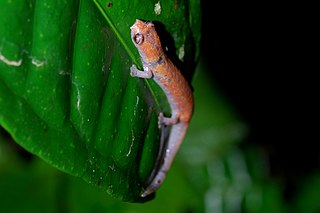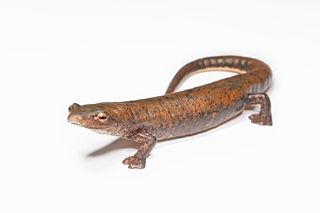Plectrohyla hartwegi is a species of frog in the family Hylidae. It is found in the Sierra Madre de Chiapas and eastern Oaxaca in Mexico, Sierra de los Cuchumatanes in western Guatemala as well as Sierra de las Minas in eastern Guatemala, and Sierra de Omoa in southwestern Honduras. It might be a composite of two or more species.

Alberch's salamander is a species of salamander in the family Plethodontidae. It is endemic to mexico and known from Veracruz, extreme eastern Oaxaca, and western and central Chiapas, from near sea level to 1,800 m (5,900 ft) asl. Its natural habitats are tropical lowland forests. It also occurs along the edges of clearings and well-shaded plantations. It seems to be a fairly common species, although it is threatened by habitat loss caused by agriculture, wood extraction, and human settlement.

Nauta salamander, also known as the Nauta mushroomtongue salamander, is a species of salamander in the family Plethodontidae. It is found on the eastern and lower slopes of the Andes from Venezuela and Colombia through Ecuador and Peru to Bolivia and east into adjacent Brazil. Its common name refers to its type locality, Nauta, in the Loreto Province, Peruvian Amazon. It might be a composite of several species.
Bolitoglossa engelhardti is a species of salamander in the family Plethodontidae. It is found in the extreme south-eastern Chiapas, Mexico, and eastward along the Pacific versant to Volcán Atitlán in south-western Guatemala. It is named for Teodoro Engelhardt, Guatemalan plantation owner who entertained Karl Patterson Schmidt and his expedition. Its common names include Engelhardt's salamander, Engelhardt's mushroomtongue salamander, and Engelhardt's climbing salamander.
The Paramo Frontino salamander is a species of salamander in the family Plethodontidae. It is endemic to the Western Ranges of the Colombian Andes where it is known from the area of its type locality, Páramo Frontino. It is also known from the Colibri del Sol Bird Reserve near Urrao. both areas are in the Antioquia Department.
The San Gil climbing salamander, also known as the San Gil mushroomtongue salamander, is a species of salamander belonging to the family Plethodontidae. It is endemic to Colombia, and its natural habitats are tropical highly humid forests; it has also been reported from a coffee plantation. The greatest threat posed to this species is habitat loss, however they are currently nowhere near the risk of extinction. The species' name honors Antoine Rouhaire, a French naturalist who collected the species holotype.
Bolitoglossa oresbia is a species of salamander in the family Plethodontidae. It is endemic to Honduras and is known from the summit of Cerro El Zarciadero and the southwestern side of the nearby Cerro Azul Meámbar National Park, in the northern Comayagua Department.
Bolitoglossa orestes, commonly known as the Culata mushroomtongue salamander, is a species of salamander in the family Plethodontidae. It is endemic to the Mérida state of Venezuela.

Bolitoglossa pandi is a species of salamander in the family Plethodontidae. It is endemic to the Cundinamarca Department of Colombia and only known from three locations on the western slopes of the Cordillera Oriental, including its type locality, Pandi; it is named after the type locality where it had been collected 50 years before being described as a new species in 1963.
Bolitoglossa porrasorum is a species of salamander in the family Plethodontidae. It is endemic to the mountains of north-central Honduras. Common name Pijol salamander has been proposed for this species in reference to its type locality, Pico Pijol. The specific name porrasorum honors of Jorge Porras Ziuniga and Jorge Porras Orellana, father and son, who provided friendship and assistance to the describers of this species.
The northern banana salamander, also known as common dwarf salamander or rufescent salamander, is a species of salamander in the family Plethodontidae. It is found in the Atlantic slopes of Meso-America from San Luis Potosi, Veracruz, and northern Chiapas in Mexico continuing on to the southern part of Guatemala, Belize, and northern Honduras. However, its range south of Mexico is uncertain because the records may refer to other species.

Savage's salamander, also known as Savage's mushroomtongue salamander, is a species of salamander in the family Plethodontidae. It is endemic to the Sierra Nevada de Santa Marta in northern Colombia. The record from Venezuela represents another species, likely Bolitoglossa guaramacalensis. The species is named after Jay M. Savage, an American herpetologist.

The Cocle salamander, also known as the Cocle mushroomtongue salamander, is a species of salamander in the family Plethodontidae. It is found in Costa Rica and Panama. In Costa Rica, it is only known from the southeastern part of the country on the Atlantic versant, whereas in Panama it is more widespread and occurs also on the Pacific versant. Its natural habitats are humid lowland and montane forests. It is a common species in Panama, whereas it is only known from a single specimen in Costa Rica. It is threatened by habitat loss.
Cryptotriton monzoni is a species of salamander in the family Plethodontidae. It is endemic to Guatemala and known only from near its type locality, Cerro del Mono near La Unión, Zacapa Department. The specific name monzoni honors José Monzón, a Guatemalan entomologist who helped the authors with the fieldwork. Common name Monzon's hidden salamander has been coined for it.
Cortes salamander is a species of salamander in the family Plethodontidae. It is found in the Sierra de Omoa in northwestern Honduras and Sierra de Caral in eastern Guatemala, close to the border with Honduras. The vernacular name Cortes salamander refers to the Cortés Department where the type locality is located, whereas the alternative name Cortez' hidden salamander with the spelling "Cortez" and the apostrophe are errors.

Dendrotriton rabbi, commonly known as the Guatemalan bromeliad salamander, is a species of salamander in the family Plethodontidae. It is endemic to Guatemala and is known from the Montañas de Cuilco, near the Mexican border, and from the Sierra de los Cuchumatanes. Its range might extend into Mexico.

Pseudoeurycea lynchi, commonly known as the Veracruz green salamander, is a species of salamanders in the family Plethodontidae.
The southern giant salamander is a species of salamander in the family Plethodontidae. It is endemic to Mexico and known from the Sierra Madre del Sur of western and southern Oaxaca and eastern Guerrero. It is the largest tropical salamander; the holotype had a total length of about 24 cm (9.4 in) and weighed 58 grams (2.0 oz).
Isthmura naucampatepetl, commonly known as the Cofre de Perote salamander, is a species of salamanders in the family Plethodontidae. It is endemic to the Sierra Madre Oriental in central Veracruz, Mexico, where it is known from between Cofre de Perote and Cerro Volcancillo, a satellite peak of Cofre de Perote.








